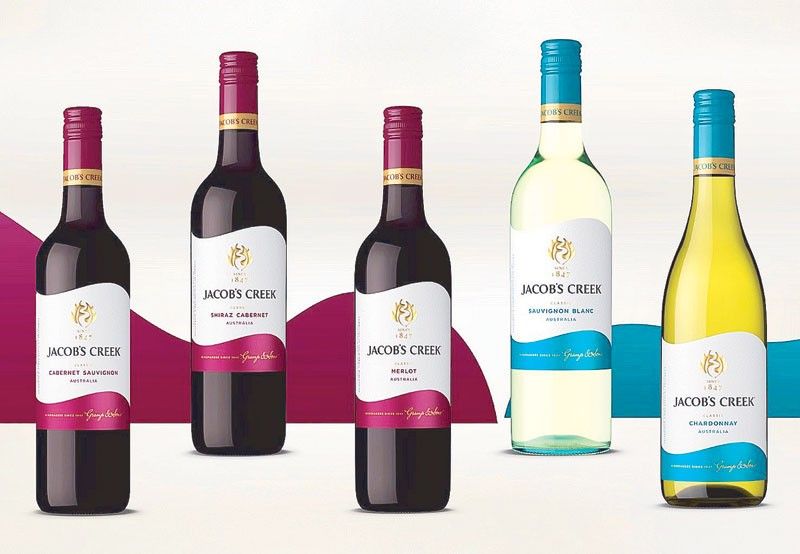A new look for Jacob's creek?

MANILA, Philippines — When you reach for a wine bottle from store shelves in the Philippines, you are very likely to spot Jacob’s Creek. It’s a hugely popular, available and “easy” Australian wine that people open now, not later. (Part of Australia’s New World wine philosophy: “Drink now.”)
In fact, Jacob’s Creek, which started after Bavarian immigirant Johann Gramp arrived at Reeve’s Point on Kangaroo Island back in 1837 (part of the first big wave of European immgration) and decided to start planting the first grape vines in Barossa Valley a decade later, is now the No. 1 bottled wine in Australia, with over 8,800 awards in its 170-year history.
So why did Jacob’s Creek decide it needed a makeover?
“Imagine you’re walking past your barber or hairdresser, and your favorite cutter isn’t there,” says wine ambassador Billy Brigham during a virtual unpacking of the new bottle designs. “So you try something new and go, ‘Man, that’s really good.’ We’re all about innovation, going outside the box. Before, there wasn’t a lot of creativity or change in our label. This label will stand for a long time. It plays with the heritage.”
Brigham walks us through the evolution of the Jacob’s Creek bottle: it’s true, there’s a consistency to the font and label since the first 1973 Shiraz Cabernet rolled out, with its bold black name and varietal in red, and only subtle changes in the onrnamentation and information on the bottle for nearly half a century.
But the addition of a logo has opened up the design: the new look is younger, and more importanly to Tony Atayde, head of marketing for Pernod Ricard, “It makes it stick out longer for customers.”
The logo reflects aspects of Jacob’s Creek’s long history: two wine leaves facing together in gold, with a curved line between them representing Jacob’s Creek waters, and a subtle wine glass shape suggested over it. Classic, yet “refreshed.” In addition, Jacob’s Creek plays with a wave design on the label, also suggesting the water banks where Gramp planted his vineyards in 1847.
Australia, as we know, has a different approach to winemaking. For Jacob’s Creek, that comes down to climate and soil. Australia pioneered shiraz grape growing, and it’s now become 30 percent of the country’s varietal production. (Some of the oldest granache grape vines are now in Australia, as most of Europe’s original granache plantings were destroyed by an infestation of bark beetles several years back.)
South Australia focuses on four regions — Barossa, which has grown from Gramp’s pioneering vineyards to become a top wine-producing region; Adelaide Hills; Riverland; and Coonawarra, whose rich red soils are among the oldest on the planet.
If you’ve noticed a certain brightness and “wow” effect to Australian wines, it has to do with high sunshine days and temperatures, and low humidity and rainfall: the perfect Mediterranean-style ingredients for full-bodied reds and robust whites. The complex valleys, twisting hills and varied slopes make for interesting soil combinations, like Coonawarra, which has hints of gum tree and eucalyptus in the resulting grapes, or Barossa, where the soils change from sandy in the north to clay-like conditions in the south.
Part of the Gramp & Sons winemaking team are chief winemaker Dan Swincer and group white and sparkling winemaker Trina Smith, who ensure that the best blends of shiraz, cabernet sauvignon, chardonnay, merlot and sauvignon blanc come to the fore in their vineyards. Consistency is maintained through a combination of stainless steel vatting and oak barreling.
Brigham led us through the taste profile of five bottles: Sauvignon Blanc (crisp, herbaceous, with hints of passionfruit; good on its own, with sushi or green salads; Brigham likens the nose to “freshly cut grass”); Classic Chardonnay (a more citrusy/melon palate; creamier due to oak aging; more lush, with some vibrant fruit and oaky notes; good with grilled fish or creamy chicken pasta); Cabernet Sauvignon (black fruits, dark cherries; some herbaceous and minty notes; perfect with slow-roasted lamb or steak); Classic Merlot (intense blackberry and spice notes; some vanilla and dark berry notes; mocha oak); and the standard bearer, Shiraz Cabernet (a deep-purple, full-bodied combination of red fruits, black pepper and mixed spice; stands up well to pork and casserole dishes).
The thing that Brigham, Atayde and managing director Fadil Tasgin wanted to emphasize is that Jacob’s Creek offers “premium, yet affordable” bottles for brand-new wine drinkers, people looking to dip their toes in wine culture. In the Philippines, that’s still a market that has room to grow. “It’s a perfect brand to start your wine journey,” says Brigham. “You can continue that journey for years, experience different varieties and pairings. There’s something for everyone,” from the sweeter moscatos, to the reislings, all the way up to the reserves and double barrels.
Atayde says the nice thing about Jacob’s Creek is, “It’s easy to use.” True, one just chills a bottle, unscrews the cap, and pours a glass — as we did during the tasting. Not complicated. Like Brigham’s “barber” analogy, one may think of Jacob’s Creek as a training manual for wine: a great way to explore the varietals, discern the differences between shiraz and cabernet and merlot, or simply keep it around for friends or meals, ready to open.
With a new look and focused marketing strategy, Jacob’s Creek remains a bottle that people everywhere in the world continue to reach for.
* * *
Follow Jacob’s Creek on Facebook and check out Jacob’s Creek on Boozy.



















